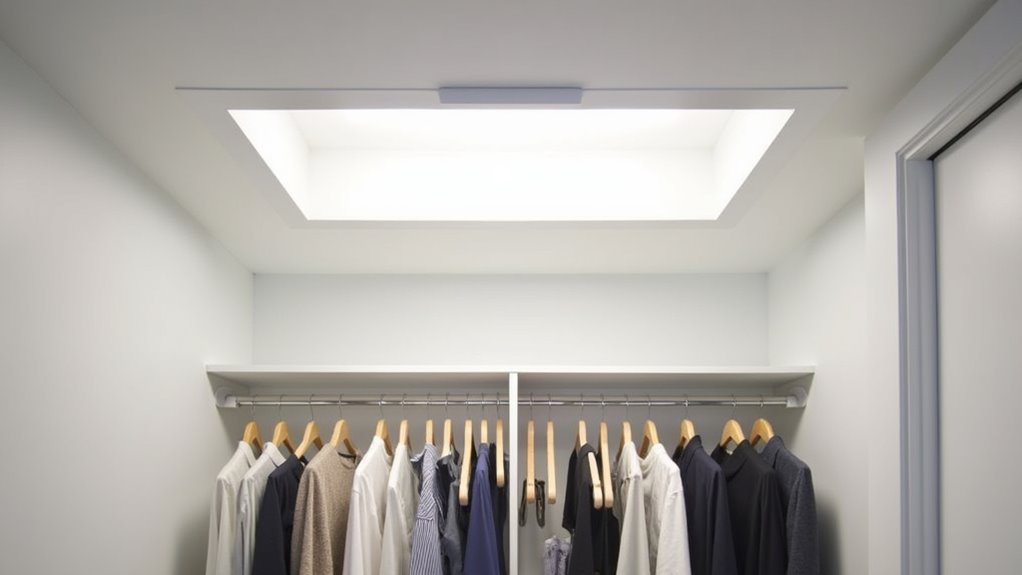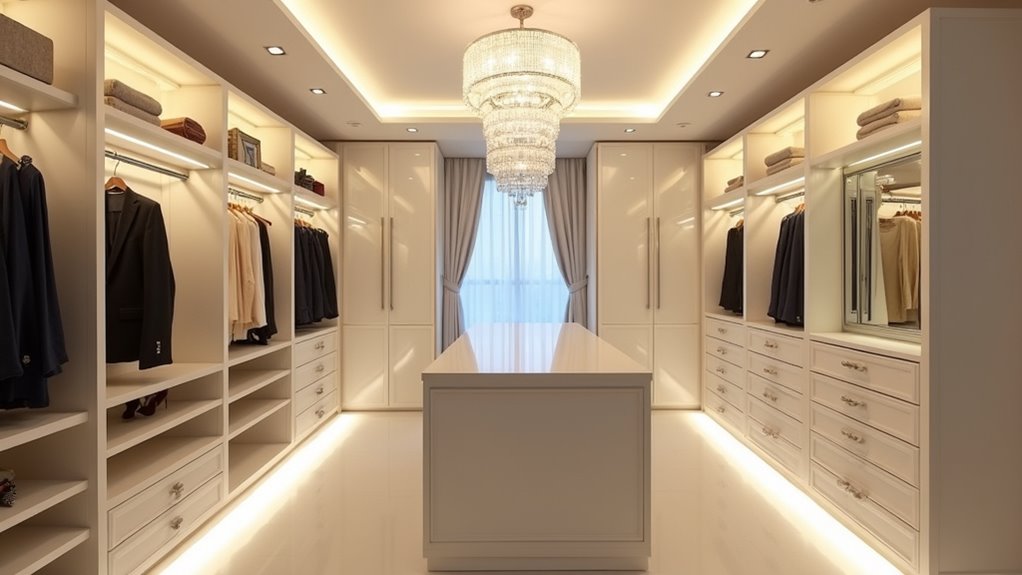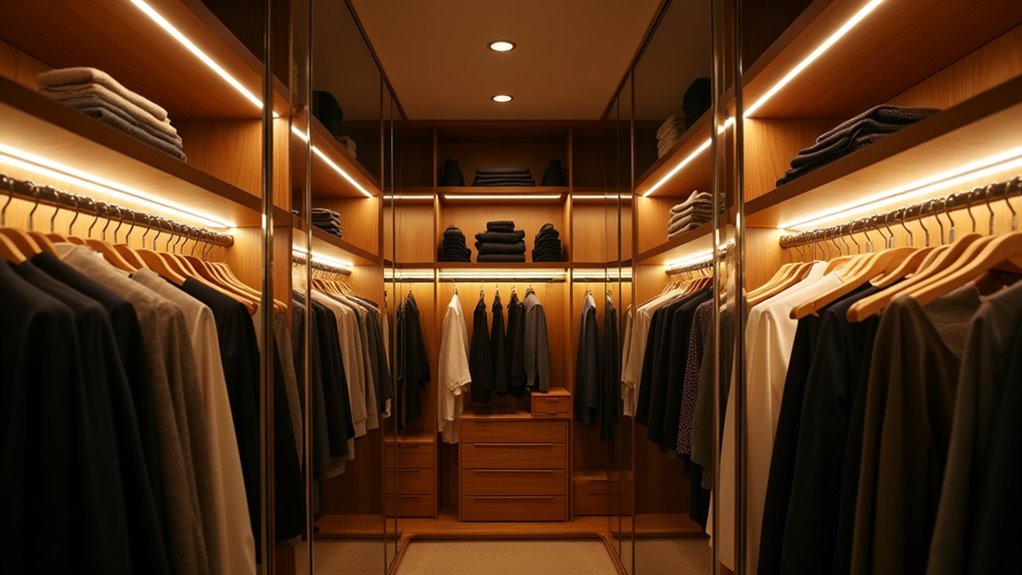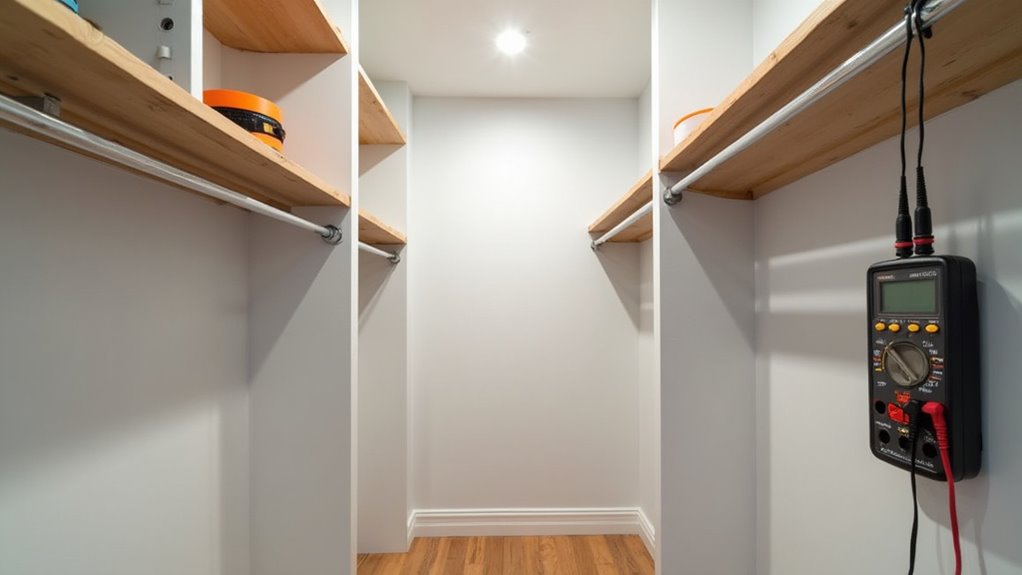You’ll transform any closet with these seven approaches: integrated LED strips that bend around irregular geometries, motion-sensor fixtures with customizable detection ranges, smart bulbs offering voice and app control, recessed mounts preserving clean sightlines, battery-powered solutions requiring zero rewiring, layered zones combining ambient and task illumination, and dimmable systems with stepless brightness adjustment. Each method addresses specific spatial constraints while delivering high-CRI output for authentic color rendering. The strategies below reveal how to implement these solutions for seamless integration and ideal functionality.
Integrated LED Strip Lighting for Flexible Installation
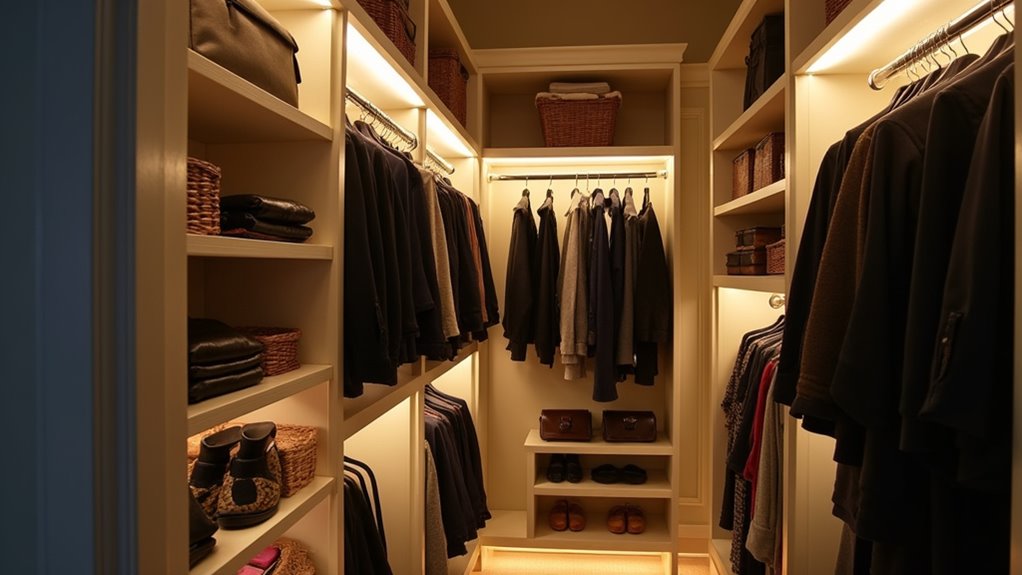
Because closets often present spatial constraints and irregular geometries that challenge conventional fixtures, integrated LED strip lighting has emerged as the preeminent solution for illuminating these shifting spaces. You’ll achieve seamless integration through bendable profiles that conform to shelving contours, while strategic placement within aluminum channels delivers diffused illumination and eliminates harsh glare. The system’s inherent adaptability allows precision cutting at designated intervals, enabling custom-fit installations across wood, metal, or composite surfaces.
Color temperature versatility spans from warm 2700K ambiance to crisp 6000K task lighting, ensuring authentic garment representation through high-CRI output. You’ll optimize visual clarity while capitalizing on energy efficiency advantages inherent to low-voltage operation, typically 12V or 24V systems that provide superior luminous efficacy. Dimmable controllers further refine your lighting strategy, converting effortlessly between accent and functional illumination requirements. Smart home integration enables voice-activated control through platforms like Alexa or Google Home, streamlining your daily closet routines. Professional installation requires Class 2 power supply pairing with each lighting run to maintain UL compliance and ensure safe operation within residential applications.
Motion Sensor Fixtures for Hands-Free Convenience
- Photo cell automation adjusting to ambient light conditions
- Customizable detection ranges spanning 10–20 feet for suitable responsiveness
- Day/night mode programming preventing unnecessary daytime activation
- Auto-off timing eliminating residual energy waste
Installation versatility accommodates both hardwired J-box configurations and wireless mounting solutions, while low-profile designs—from 4-inch recessed fixtures to slim-bar formats integrate seamlessly within diverse closet architectures. These energy-efficient solutions deliver 600 Lumens of brightness while consuming only 10 Watts, matching the output of traditional 50-Watt incandescent bulbs with significantly lower energy consumption. Hands-free operation ensures lights activate only when needed, maximizing convenience in small closets and pantries. Battery-operated options eliminate the need for existing electrical wiring in closets.
Smart Bulbs and Wireless Controls for Voice and App Management
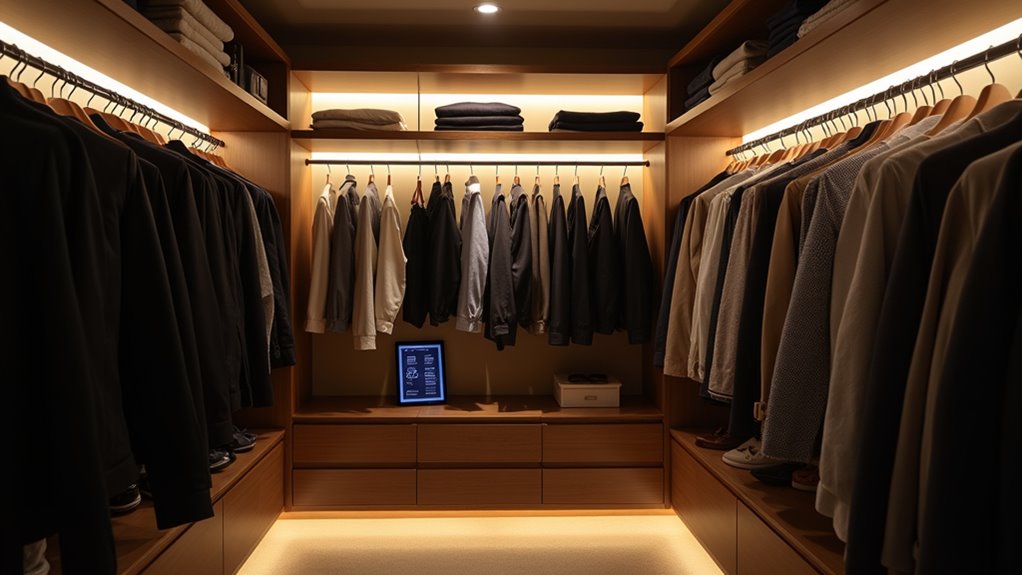
While motion-activated fixtures address hands-free operation through physical presence, smart bulbs extend control paradigms into digital ecosystems where voice commands, mobile applications, and scheduled automation converge. You’ll find integrated voice control through platforms like Alexa or Google Assistant enables effortless adjustments to brightness, color temperature, and hue, transforming closet ambiance without physical switches. Wireless protocols, including Wi-Fi, Bluetooth, and ZigBee eliminate rewiring requirements, making retrofit installations straightforward in existing spaces. App-based interfaces support custom scene creation, grouping multiple fixtures, and remote access when you’re away. Automated location-based lighting employs smartphone GPS or presence sensors to trigger illumination upon approach, merging convenience with energy efficiency. LED smart bulbs deliver sustainability through reduced consumption, extended lifespan, and real-time usage monitoring, optimizing both aesthetic intent and operational costs. Smart fixtures with motion sensor capabilities can further reduce energy consumption by automatically powering down when the closet remains unoccupied. Engineers must ensure all installations comply with local electrical codes and safety regulations, particularly when integrating smart technology into residential closet spaces.
Recessed and Flush Mount Fixtures for Sleek, Even Illumination
Recessed and flush mount fixtures deliver a streamlined ceiling plane that preserves your closet’s visual clarity while eliminating protrusions that compromise headroom or interfere with shelving. Their low-profile architecture integrates seamlessly into contemporary and traditional design schemes, ensuring illumination remains functional yet architecturally unobtrusive. Adjustable beam placement options allow you to direct light precisely where garments hang or shelves reside, creating targeted coverage that reduces shadows and boosts the visibility of textures and colors. Smart recessed fixtures offer personalized lighting experiences through adjustable brightness and color temperature settings that adapt to different times of day or specific wardrobe tasks. In walk-in closets, position recessed lights in a grid pattern across the ceiling to achieve uniform illumination throughout the entire space. These fixtures provide 100-200 lumens per square foot, delivering adequate brightness for effective closet organization and garment selection.
Low-Profile Design Benefits
Low-profile lighting transforms closet functionality by delivering sophisticated illumination without compromising precious storage space. Recessed and flush mount fixtures exemplify space-saving design, seamlessly integrating into ceiling planes while providing ample visibility. Their minimal obstruction approach proves essential for walk-in and reach-in configurations alike, where vertical clearance remains paramount.
Key advantages of low-profile fixtures include:
- Ceiling Integration – Flush installation maintains clean architectural lines
- Vertical Clearance – Eliminates interference with hanging garments and upper shelving
- Visual Continuity – Preserves uninterrupted sightlines throughout the space
- Adaptable Placement – Accommodates varied closet dimensions and ceiling heights
These fixtures deliver uniform, shadow-free illumination while reinforcing contemporary aesthetics. Whether you’re outfitting a compact linen closet or an expansive dressing room, low-profile solutions optimize both functionality and visual refinement. The streamlined design requires less cleaning and maintenance compared to protruding fixtures that accumulate dust in confined spaces. LED technology enhances these benefits through longer lifespan and reduced energy consumption compared to traditional bulbs. For closets with moisture concerns, such as those adjacent to bathrooms or in humid climates, wet-rated options provide reliable performance without sacrificing the streamlined appearance.
Adjustable Beam Placement Options
Strategic positioning of recessed and flush mount fixtures improves closet illumination from functional necessity to refined design element. You’ll achieve ideal coverage through directional beam aim, particularly with 360-degree rotatable LED systems that deliver 120-degree spreads to specific zones. Grid patterns eliminate dark spots in walk-in configurations, while angled installations near openings minimize shadows on hanging garments in reach-in spaces.
Flush mount solutions preserve headroom in lower-ceiling environments without compromising light quality. The integration of adaptive sensor controls with dimmer functionality allows you to calibrate intensity for varied tasks, from morning garment selection to evening ambient settings. Select fixtures with wide beam angles to ensure comprehensive coverage throughout your closet space. When vertical beams converge from opposing sides, you’ll create seamless illumination that showcases textile colors accurately while maintaining the architectural refinement your space deserves.
Battery-Powered Solutions for Renters and Quick Upgrades
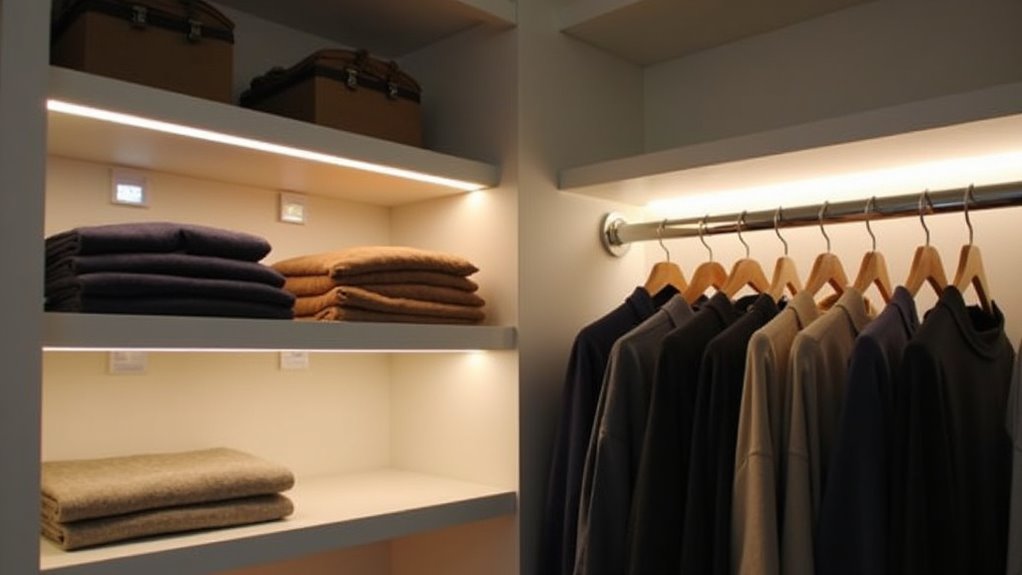
Battery-powered closet lighting delivers installation freedom through wireless designs that eliminate electrical retrofitting, ideal when you’re working within lease restrictions or seeking minimal-intervention upgrades. You’ll achieve complete spatial flexibility since these fixtures relocate effortlessly as your storage configuration evolves, mounting via adhesive systems that preserve wall integrity. Modern LED technology guarantees extended operational periods between battery changes, maintaining consistent illumination without compromising the sleek, unobtrusive aesthetic essential to refined closet environments.
No Wiring Installation Required
When permanent electrical work isn’t feasible or desirable, battery-powered lighting systems deliver professional-grade illumination without compromising wall integrity or requiring contractor involvement. Adhesive backing and magnetic mounting mechanisms enable tool-free installation across diverse surfaces, from shelf undersides to closet ceilings, while maintaining complete repositioning flexibility. Contemporary designs prioritize mounting flexibility innovations through Command™ Strip compatibility and peel-and-stick solutions that eliminate hardware damage entirely.
Essential installation considerations include:
- Motion-activated LED bars with 15-foot detection ranges and 20-second auto-shutoff sequences
- USB-rechargeable models offering 1–3 months operational duration between charging cycles
- Lumen outputs spanning 30–300+ for customized brightness levels
- Charging station needs integrated into closet design workflows
Strip configurations adapt to rod placement and corner geometries, while lightweight construction prevents mounting sag. These solutions prove particularly advantageous for temporary residences requiring damage-free removal.
Relocatable as Needs Change
Because spatial requirements evolve throughout a residence’s lifecycle, from seasonal wardrobe rotations to nursery conversions, battery-powered closet lighting delivers architectural-grade illumination without permanent infrastructure commitments. Command™ Strips and adhesive pads enable seamless repositioning across shelving configurations, wall planes, and cabinet interiors without compromising finish integrity. You’ll preserve deposit security while maintaining grab and go accessibility for fixtures weighing under 1.5 lbs, ideal for adaptive layouts. Slim profiles with frosted lenses integrate discreetly into evolving aesthetic schemes, whether scaling from single puck installations in compact linen storage to linked strip arrays illuminating walk-in wardrobe expanses. Modular designs support incremental upgrades as spatial functions shift, while rechargeable battery platforms eliminate disposal waste. This flexibility accommodates dynamic residential programming without renovation-level investment or electrical modifications.
Long-Lasting LED Battery Life
- Completing full 3.8-hour USB recharge cycles as indicated by completion LEDs
- Avoiding partial charges that compromise lithium-ion cell calibration
- Maintaining moderate activation frequencies (eight daily cycles or fewer)
- Positioning sensors to minimize false triggers from ambient movement
Mid-range 1500mAh configurations deliver 2.1-month autonomy under standard usage patterns, while energy-efficient LED arrays produce 220 lumens without excessive drain. USB-rechargeable architecture eliminates disposable battery waste, supporting sustainable operation throughout extended service lives.
Layered and Zoned Lighting Design for Comprehensive Coverage
Three distinct lighting layers form the foundation of exceptional closet illumination, each serving a specific purpose in creating a cohesive visual and functional environment. Ambient fixtures establish uniform brightness throughout your space, while task lighting concentrates intensity where you’re selecting garments or accessories. Targeted accent lighting enhances displays, spotlighting shoe collections or handbag arrangements with architectural sophistication.
You’ll achieve complete coverage by implementing zoning strategies that segment your closet into functional districts. Assign independent controls to each zone, allowing precise adjustment based on immediate needs. Track systems offer reconfigurable flexibility, adapting as your storage evolves. Vertical LED strips eliminate shadowing along hanging rods, while under-shelf installations illuminate lower levels.
Optimized color rendering through high-CRI LEDs guarantees accurate wardrobe coordination across all zones, transforming your closet into a thoughtfully curated space where nothing remains hidden.
Dimmable Options for Adjustable Brightness Throughout the Day
Why settle for static illumination when your closet’s lighting can adapt seamlessly to morning routines, midday outfit changes, and evening preparations? Dimmable LED solutions, including strip lights, smart bulbs, and light bars, deliver stepless brightness control from 5–100%, ensuring energy efficient performance across all usage scenarios. High-CRI fixtures provide optimized color rendering for accurate garment assessment, while smart integration enables app-based or voice-activated adjustments through platforms like Google Home and Alexa.
Core dimmable technologies for adaptive closet illumination:
- Motion and door sensors with brightness memory for automatic dimming cycles
- Wireless remotes (STYRBAR, SOMRIG) enabling instant adjustment without rewiring
- Scene presets for morning, midday, and evening lighting configurations
- Compatible dimmer switches ensuring flicker-free performance and extended LED lifespan
These systems reduce heat output while supporting zone-specific control in multi-area closets.
Frequently Asked Questions
What Color Temperature Is Best for Closet Lighting?
For ideal closet lighting, you’ll want a color temperature between 3000K and 4000K. This range delivers perfect brightness while ensuring color consistency when selecting garments. The neutral white tone provides accurate color rendering without harsh cool tones or overly warm yellows that distort fabric hues. If you’re designing a multi-functional space, 3500K offers the perfect balance, crisp enough for precision tasks yet warm enough to maintain an inviting aesthetic that complements your interior design vision.
How Do I Calculate Lumens Needed for My Closet Size?
Calculate your closet’s lumens by multiplying square footage by 20-50 foot-candles based on your desired brightness. Consider lighting distribution factors like ceiling height and wall color, darker surfaces require increased output. Closet layout considerations such as shelving depth and alcoves create shadows that demand higher lumens. Add 15% for light loss over time. For ideal results, you’ll need approximately 30 foot-candles for standard use, ensuring uniform coverage throughout your space’s architectural features.
Can Smart Closet Lights Work Without Wi-Fi or Internet Connection?
Yes, you’ll find most smart closet lights function independently without Wi-Fi connectivity. Battery-powered options equipped with motion sensors provide seamless automated illumination without internet dependency. While voice-activated control typically requires connectivity for integration with smart home systems, fundamental lighting operations remain unaffected. You can achieve sophisticated, design-forward illumination through sensor-based activation, tap controls, or remote functionality, all operating offline. This approach guarantees your closet’s aesthetic lighting scheme maintains reliability while preserving the sleek, contemporary design you’re cultivating.
Do LED Closet Lights Interfere With Clothing Fabrics or Colors?
LED closet lights present minimal fabric damage potential due to their low UV emissions and reduced heat output, making them ideal for textile preservation. However, you should consider clothing color alteration effects, as lower-quality LEDs may distort color perception during garment selection. High-CRI fixtures guarantee accurate color rendering while protecting your wardrobe. You’ll optimize fabric longevity by implementing motion sensors, maintaining appropriate fixture distances, and using protective garment covers for delicate pieces.
What Maintenance Is Required for Different Closet Lighting Types?
You’ll need regular bulb replacement for traditional fixtures, while LEDs minimize this task considerably. Timely switch inspection guarantees excellent performance across all systems. Motion sensors require periodic calibration to maintain responsive activation, and you should dust all fixtures quarterly to preserve luminous efficacy. Recessed installations demand professional assessment for proper thermal management, whereas surface-mounted designs allow easier access. Strategic maintenance scheduling amplifies your lighting’s aesthetic impact while preventing degradation that compromises your closet’s visual clarity and functional brilliance.

